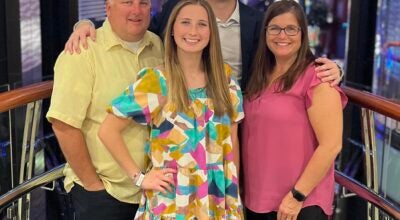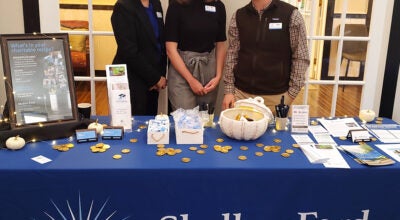Youth’s video takes 2nd in national math contest
Published 12:00 am Thursday, June 26, 2014
By Jim Buice
The Clemmons Courier
When it comes to using GPS (global positioning system), Lewisville teenager David Hamilton admits he doesn’t know much about it.
David, who turned 16 in May, has his driver’s permit and will soon get his license, but he and his family don’t use it much to navigate. He does wear a watch when he runs that uses GPS to tell him how far and fast he’s going.
However, he learned a great deal in a recent crash course dealing with the math involved in the GPS, and the resulting video that he created paid huge dividends as he finished second in Math-O-Vision put on by Dartmouth College.
The national competition for high school students to create four-minute movies to show how math fills our world netted David $2,000 as the runner-up.
“I spent several days trying to come up with a topic,” David said. “At one point, I had it narrowed down to two ideas, but I soon realized that I didn’t like either of them. The GPS idea was kind of random. It was something I had been thinking about recently, and I knew there had to be some interesting math involved. I chose it so that I, and hopefully the viewers, could learn something in the process.”
He found out about this contest in mid-April, and with a deadline of May 1, David knew he was in a bit of a time crunch to produce “The Math Behind Your GPS.”
David started his research on April 23, then wrote his script, filmed the narration and drawings, and proceeded to deal with all the details of producing the video.
“It was a race against time,” he said. “I was finally ready to submit my video at about 1 a.m. on Thursday, May 1, with 11 hours to spare before the deadline. I would estimate that I spent about 36 hours producing the video during the one-week period after all of the research.”
He selected his 7-year-old sister, Lizzie, sitting behind a school desk with her pigtails, cute face and animated hand gestures, to do the narrating.
“I chose my sister to do the explaining because I knew she had the right personality to give the video the feel that I wanted,” David said.
The Math-O-Vision competition included online voting, but the winners were ultimately chosen by a five-member panel of judges, including Alan Alda, a former Emmy-award winner who is currently a professor at SUNY Stony Brook.
Alda was impressed with the video and little Lizzie.
“This video actually teaches some math,” he said. “It’s creative, and the girl is adorable.”
The oldest of five children, David is the son of Kevin and Kristen Hamilton of Lewisville. His two brothers and two sisters range in age from 3 to 14,
He is home-schooled, and his mother is his primary instructor. His dad is a science and engineering teacher at Atkins High School in Winston-Salem.
David said that he never liked math until around the seventh grade, but it has now become one of his favorite subjects in school. He plans to take calculus next year.
As for putting together the math involved with GPS, he found most of the facts and figures online and also did a little figuring on his own.
“I spent a whole day doing research, and I tried to find multiple sources for everything,” David said. “There was some discrepancy between sources on a few of the numbers, some of which I calculated out myself and rounded to a safe estimate, and others I opted to leave out. One article that I read stated that the Earth’s gravity is four times weaker where the GPS satellites orbit than on the ground, but by my own calculations it should be 17 times weaker.”
This wasn’t David’s first video contest. Earlier this year, he won $1,000 for his two-minute video on Genes & Traits, which was sponsored by ProjectEd.com. David appears on this video, but Lizzie is the main narrator.
As for the future, expect David to be making more videos, especially for contests. Preparing for his junior year, he plans to be home-schooled through high school but “can’t say much about college yet.”
And if he and his family decide to start using GPS going forward, they are now much better equipped, thanks to the “The Math Behind Your GPS” video he produced.
“We don’t actually use GPS much at all to navigate,” David said. “Most of my family certainly understands better how the system works because of my video. I can’t say much for my 3-year-old brother though.”
In his own words:
How he did it
I did most of my research on Wednesday, April 23, then I wrote my script and did my fact-checking the next day.
On Friday morning, I filmed the narration. I used my Canon Rebel T3i DSLR camera for video and an old Flip cam placed near the desk for audio. For the drawings, I used a big roll of white paper on our dining room table with the camera mounted on the opposite side from which I would be drawing, and as high as I could get it, nearly touching the ceiling.
The height was to minimize the camera angle’s difference from the ideal angle, which would be perpendicular to the tabletop. I could not put the camera directly above the paper because the tripod legs would get in the way; even with the legs spread out, the legs would cast shadows on the paper.
I planned everything one step at a time. Once I had the narration filmed, I knew I had a ‘base’ for my video, to which I was adding visuals. My schedule was pretty much to film during the day and edit for a few hours each night, so I drew whatever visuals I could think of during the day, while getting closer and closer to that ‘base’ every night.
For the most part, I drew the things that were absolutely crucial first, like the trilateration diagram, before the less important, gap-filling drawings, like the launch sketch. I planned out several of the drawings on the computer, and slipped a lightly printed version underneath the paper to trace.
The first couple of nights of editing were just sorting through all of the footage, aligning the audio and getting everything in one place. I quickly moved on to doing the more difficult animation.
Almost all of the animations were created in my video editing software, using keyframing techniques. (I used Adobe Premiere Elements 10 for that video, but now I am working on learning Premiere Pro.) The exception is the satellite orbiting and falling. For those, I wrote a computer program that generated the animation frame-by-frame given the starting speed I wanted in vectors.
By Tuesday afternoon I had a rough cut, and I was able to show it to some friends. This helped me to see some simple things to improve, like where some additional visuals would help. I recorded these as well as the title screen and a couple of equations later that day, and I had Wednesday evening left to finish editing. The main challenge at that point was to get everything into the four-minute limit.
I also added some sound effects and some simple extra animation. This is probably my favorite part of production; the very last bit of editing, especially in a time crunch. I was finally ready to submit my video at about 1 A.M. on Thursday, May 1, with 11 hours to spare before the deadline.
To see the video:
To see David Hamilton’s video, “The Math Behind Your GPS,” visit http://www.youtube.com/v/pX6PcRN6Kow?version=3&f=videos&app=youtube_gdata&rel=0. For his earlier video, “Genes & Traits,” visit https://www.youtube.com/watch?v=9bfAOx5y6ME



